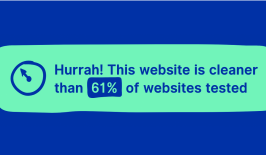Did you know that every old email stored in your inbox is using up energy? Decluttering your inbox is a quick and easy way to reduce your electricity consumption and shrink your carbon footprint.
In this day and age, it is difficult to imagine our lives without e-mail. But how often do we consider the environmental impact of these virtual messages? At first glance, digital messages appear to save resources. Unlike traditional letters, no paper or stamps are needed; nothing has to be packaged or transported. Many of us tend to assume that using email requires little more than the electricity used to power our computers. It’s easy to overlook the invisible energy usage involved in running the network (and maintaining the entire physical infrastructure behind it) – particularly when it comes to sending and storing data.
Every single email in every single inbox in the world is stored on a server. The incredible quantity of data requires huge server farms – gigantic centres with millions of computers which store and transmit information. These servers consume massive amounts of energy, 24 hours a day, and require countless litres of water, or air conditioning systems, for cooling. The more messages we send, receive and store, the more servers are needed – which means more energy consumed, and more carbon emissions.
According to carbon footprint specialist Mike Berners-Lee (brother of Tim Berners-Lee, the “inventor of the world wide web”), every spam email – even if we don’t open it – releases an estimated 0.3 grams of CO2 into the atmosphere. An email with a lot of text and an attachment can be responsible for up to 50 grams. These carbon emissions come from the energy used to operate the computers, access the internet and the entire physical system and the infrastructure behind it all, including the storage and transmission of information via data centres. Spam messages accounted for a whopping 54.68 percent of all emails worldwide in 2019 (that’s big emissions’ reduction potential with something as simple as a good spam filter!). However, these calculations were made by Berners-Lee ten years ago, so the real impact may actually be even higher.
More recent calculations come from energy supply company Ovo Energy who worked out that if every email user in the UK sent one less unnecessary email each day, it would reduce CO2 emissions by 16,433 tonnes each year – which is the same as 81,152 flights between London and Madrid!
It’s definitely worthwile taking a few minutes to do an eco-friendly digital detox: avoiding sending unnecessary mails, reducing the amount of spam you receive and regularly cleaning out your inbox.
Here are a few good e-mail habits that will help you keep your e-mail inbox clean and eco-friendly.
- Search and destroy: Once a month, scan your inbox for old, unnecessary e-mails that you can delete. Pay particular attention to those with bulky attachments.
- Take out the trash: Empty your Junk E-mail folder regularly. (Some e-mail programs do this automatically. Check the settings on yours and choose a shorter storage period if necessary.)
- Manage your subscriptions: If you are subscribed to newsletters, reassess which ones you really need/enjoy reading. Do most of them simply sit unopened in your inbox? In that case, it might be time to unsubscribe from some of them. This handy guide shows you the quickest and most effective way to do that depending on what mail program you’re using.
- Turn off social media notifications: If you receive notification e-mails from social networks such as Facebook, LinkedIn and Twitter, deactivate them unless you really need them. Most of the time, they just duplicate information you already receive directly through the network’s website or app.
- Choose a green e-mail provider: There are now a number of email services that use 100% on green electricity, including Posteo.de, Mailbox.org, Runbox and Tutanota, to name just a few. They also have an added bonus – they’re free from advertising, meaning they protect users’ privacy and don’t track you online or sell your data to third parties. If you are concerned about protecting your personal data online more generally, you can also look at the Data Detox Kit.
Clearly, sending and receiving electronic messages in an environmentally conscious manner is by no means enough to stop climate change. But with a few careful, mindful changes, unecessary CO2 emissions can easily be avoided.
Want more tips on how to reduce your power consumption in everyday life? Check out RESET’s 12 tips for saving energy at home.
Last update: Leander Jones (RESET Editorial) 2020





